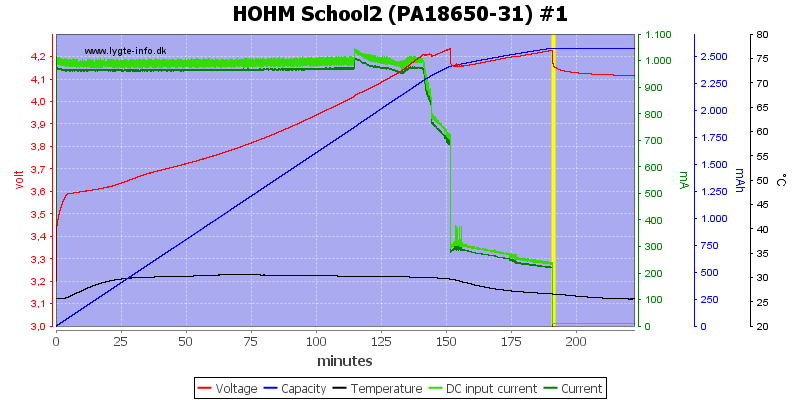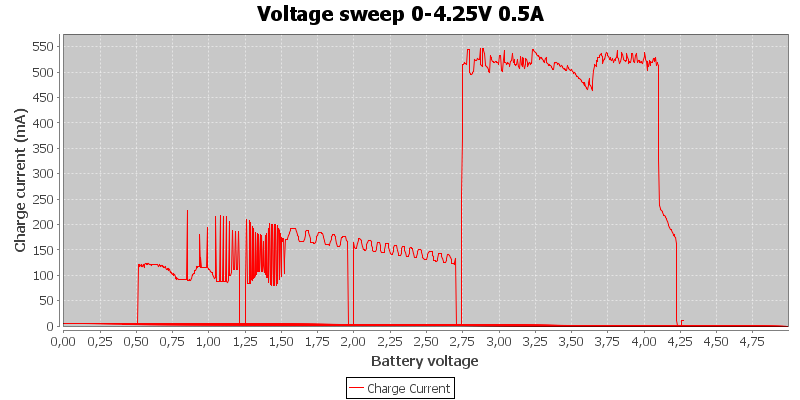HKJ
Flashaholic
[size=+3]Hohm Tech School2[/size]



A two slot LiIon only charger from Hohm Tech that is USB powered.




The charger was in a cardboard box with specifications on it.

The box included the charger, a USB cable and a instruction sheet.
The USB cable is very thick.

The charger has a USB micro input.

There are no buttons, only a led for each slot. The leds is red while charging and green when the battery is full.

There is two current settings on the charger and they are selected by the battery length. There is a nice marking showing at what point the current changes.

The charger has specifications on the back.


The connection are the common slider style that can handle from 32mm to 76mm, this means all batteries will fit.










The current for 10440 is a bit on the high side.
[size=+2]Measurements charger[/size]

The charger uses a sort of CC/CV charging, but the current drops in fairly large steps. This is not a problem for the battery, but will mean slightly longer charger time.The charge time is not that long, because the charger maintain full current up to about full battery voltage, before it is reduced. Termination current is around 160mA, this is a slight high for some batteries.

Second slot is similar, but the final voltage is slightly different.


These two batteries are similar.

The regulation has some problems with this cell, but the end result is good enough.

The smaller battery means lower charge current.

Simulating a weak charger or long cable with a 0.5ohm resistor do not prevent the charger from charging the cell, but the termination is not that good.

With two cells at 1A it cannot maintain full current as long, this means slightly longer charge time, but the end result is fine.

M1: 40.6°C, M2: 41.1°C, M3: 44.8°C, HS1: 53.3°C

M1: 57.0°C, M2: 45.4°C

The charger needs about 8 seconds to reach full current.

The charger will discharge a full LiIon battery with about 0.22mA.


The charge profile. The drop in charge current is probably heat related, the charger use a linear regulator and when the LiIon battery is at low voltage the regulator will get hotter.

The charger will not work with a unstable voltage.
[size=+2]Conclusion[/size]
It is a simple and easy to use LiIon charger that does what it is supposed to do.
I will rate it as fairly good.
[size=+3]Notes[/size]
The charger was supplied by a Hohm for review.
Here is an explanation on how I did the above charge curves: How do I test a charger



A two slot LiIon only charger from Hohm Tech that is USB powered.




The charger was in a cardboard box with specifications on it.

The box included the charger, a USB cable and a instruction sheet.
The USB cable is very thick.

The charger has a USB micro input.

There are no buttons, only a led for each slot. The leds is red while charging and green when the battery is full.

There is two current settings on the charger and they are selected by the battery length. There is a nice marking showing at what point the current changes.

The charger has specifications on the back.


The connection are the common slider style that can handle from 32mm to 76mm, this means all batteries will fit.










The current for 10440 is a bit on the high side.
[size=+2]Measurements charger[/size]
- When not powered it will discharge a LiIon battery with about than 0.22mA
- When powered the charge will charge with less than 1mA when finished.
- Below 0.5V the battery is assumed to defect and the red indicator blinks.
- Between 0.5V and 2.8V the charger will use reduced charge current
- Above 2.8V the charger will use full current.
- Charger will restart if battery voltage drops below 3.9V.
- Current changes around 60mm battery length as marked on the charger.
- Power consumption when idle without batteries is 6.1mA from USB

The charger uses a sort of CC/CV charging, but the current drops in fairly large steps. This is not a problem for the battery, but will mean slightly longer charger time.The charge time is not that long, because the charger maintain full current up to about full battery voltage, before it is reduced. Termination current is around 160mA, this is a slight high for some batteries.

Second slot is similar, but the final voltage is slightly different.


These two batteries are similar.

The regulation has some problems with this cell, but the end result is good enough.

The smaller battery means lower charge current.

Simulating a weak charger or long cable with a 0.5ohm resistor do not prevent the charger from charging the cell, but the termination is not that good.

With two cells at 1A it cannot maintain full current as long, this means slightly longer charge time, but the end result is fine.

M1: 40.6°C, M2: 41.1°C, M3: 44.8°C, HS1: 53.3°C

M1: 57.0°C, M2: 45.4°C

The charger needs about 8 seconds to reach full current.

The charger will discharge a full LiIon battery with about 0.22mA.


The charge profile. The drop in charge current is probably heat related, the charger use a linear regulator and when the LiIon battery is at low voltage the regulator will get hotter.

The charger will not work with a unstable voltage.
[size=+2]Conclusion[/size]
It is a simple and easy to use LiIon charger that does what it is supposed to do.
I will rate it as fairly good.
[size=+3]Notes[/size]
The charger was supplied by a Hohm for review.
Here is an explanation on how I did the above charge curves: How do I test a charger


